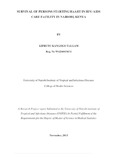| dc.description.abstract | Background: Variations in survival rates between males and females initiated on HAART have been reported in many HIV intervention programs showing increased mortality in males. It is desirable to have estimates of expected survival rates of persons living with HIV. Such variables that influence survival are important for; projecting future numbers of AIDS cases, understanding of the pathology of the disease, clinical decision making and planning health service interventions. In addition results are useful for; monitoring the progress of the HIV/AIDS epidemic, changes of treatments, enabling mathematical modeling and health care professionals to estimate future needs. This study presents survival comparisons between males and females enrolled at the same time and observed until the end of the study. These will contribute to improve health outcomes in different population settings. In addition this study identified some of the factors influencing survival by gender of persons in HAART presents the determined survival rates of HIV-infected patients treated with HAART in comprehensive care facility, in Nairobi Kenya.
Objectives: Assess the survival of persons starting highly active antiretroviral therapy in a comprehensive care facility in Nairobi, Kenya with aim of determining demographic gender characteristics and survival probabilities.
Design This was a cross-sectional retrospective study of those HIV/ADS persons on management at a HIV/AIDS health care delivery facility in Nairobi.
Main study Variables: The main study variables are demographic and clinical data. The demographic data are age, gender, marital status, occupation, level of formal education, region the person is coming from (place of residence) and monthly income. Clinical data are; whether the patient is on ART, calendar year of ART initiation, first date of clinic visit, last date of clinic visit, and mortality date.
Study population: Persons on follow up and starting HAART in a HIV/ AIDS care facility in Nairobi, Kenya.
ix | P a g e
Results: The study was conducted from 2006 to 2011 and enrolled 2453 participants; 62% female and 38% males. Mean, median and standard deviation of their ages were 33.17, 33.00 and 10.144 years respectively. At the end of the five-year with 3-month interval visits within the study period, more men than women were more likely to be marked as lost to follow up (LTFU) with adjusted hazard ratio of 1.19 at 95% Confidence interval (1.15–1.26). After adjusting for covariates at mean levels, survival and hazard functions curves showed higher survival probabilities for females compared to males and higher hazard probabilities for males compared to females. The factors that contributed significantly to the differences in mortality are levels of education, occupation and marital status of persons under study. Despite the fact that most of the data elements had no responses from the study participants, mean covariates had within - significance to the survival rates.
Conclusion: HIV-infected males have higher mortality on ART than females in this program. The variations can be attributed to differences in response to treatment. Future studies should be undertaken to determine whether the gender difference in survival rates are wholly or partly to this factor and/or Lost to follow up of target study participants. | en_US |
| dc.description.department | a
Department of Psychiatry, University of Nairobi, ; bDepartment of Mental Health, School of Medicine,
Moi University, Eldoret, Kenya | |

